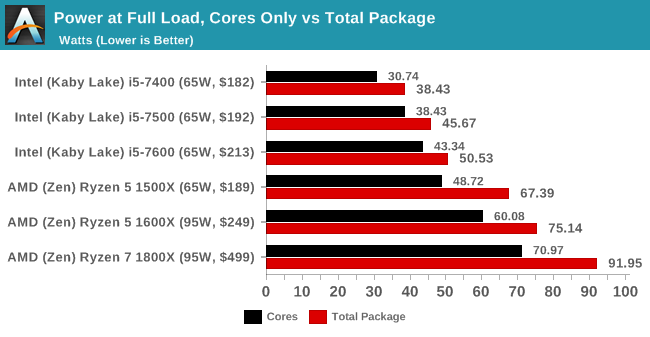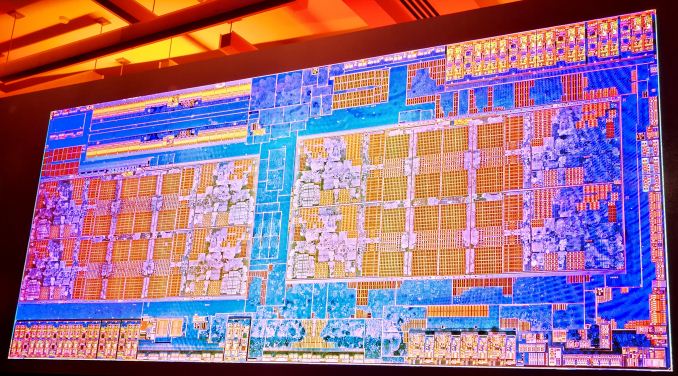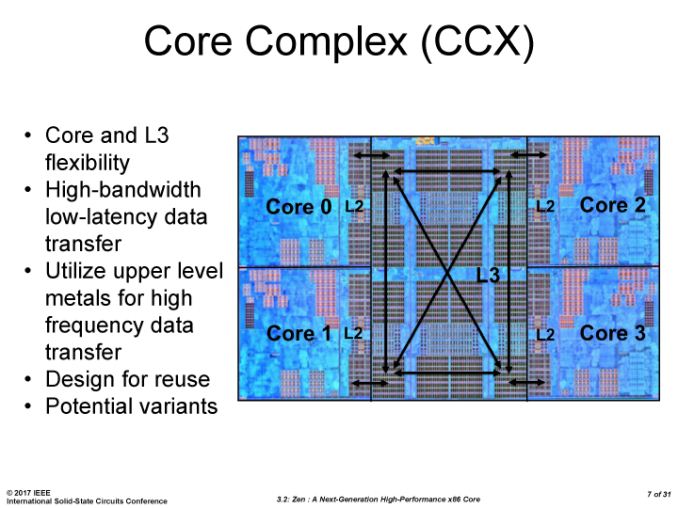The AMD Ryzen 5 1600X vs Core i5 Review: Twelve Threads vs Four at $250
by Ian Cutress on April 11, 2017 9:00 AM ESTRyzen 5, Core Allocation, and Power
In our original review of Ryzen 7, we showed that the underlying silicon design of the Ryzen package consists of a single eight-core Zeppelin die with Zen microarchitecture cores.
The silicon design consists of two core complexes (CCX) of four cores apiece. Each CCX comes with 512 KB of L2 cache per core, which is disabled when a core is disabled, and each CCX has 8MB of L3 cache which can remain enabled even when cores are disabled. This L3 cache is an exclusive victim cache, meaning that it only accepts evicted L2 cache entries, rather than loading data straight into it (which is how Intel builds their current L3 cache designs).
One of the suggestions regarding Ryzen 7’s performance was about thread migration and scheduling on the core design, especially as core-to-core latency varies depending on where the cores are located (and there’s a jump between CCXes). Despite the use of AMD’s new Infinity Fabric, which is ultimately a superset of HyperTransport, there is still a slightly longer delay jumping over that CCX boundary, although the default Windows scheduler knows how to manage that boundary as demonstrated by Allyn at PCPerspective.
So when dealing with a four-core or six-core CPU, and the base core design has eight-cores, how does AMD cut them up? It is possible for AMD to offer a 4+0, 3+1 or 2+2 design for its quad-core parts, or 4+2 and 3+3 variants for its hexacore parts, similar to the way that Intel cuts up its integrated graphics for GT1 variants.
There are some positives and negatives to each configuration, some of which we have managed to view through this review. The main downside from high level to a configuration split across CCXes, such as a 2+2 or 3+3, is that CCX boundary. Given that the Windows scheduler knows how to deal with this means this is less of an issue, but it is still present.
There are a couple of upsides. Firstly is related to binning – if the 2+2 chips didn’t exist, and AMD only supported 4+0 configurations, then if the binning of such processors was down to silicon defects, fewer silicon dies would be able to be used, as one CCX would have to be perfect. Depending on yield this may or may not be an issue to begin with, but having a 2+2 (and AMD states that all 2+2 configs will be performance equivalent) means more silicon available, driving down cost by having more viable CPUs per wafer out of the fabs.
Secondly, there’s the power argument. Logic inside a processor expends energy, and more energy when using a higher voltage/frequency. When placing lots of high-energy logic next to each other, the behavior becomes erratic and the logic has to reduce in voltage/frequency to remain stable. This is why AVX/AVX2 from Intel causes those cores to run at a lower frequency compared to the rest of the core. A similar thing can occur within a CCX: if all four cores of a CCX are loaded (and going by Windows Scheduler that is what happens in order), then the power available to each core has to be reduced to remain stable. Ideally, if there’s no cross communication between threads, you want the computation to be in opposite cores as threads increase. This is not a new concept – some core designs intentionally put in ‘dark silicon’ - silicon of no use apart from providing extra space/area between high power consuming logic. By placing the cores in a 2+2 and 3+3 design for Ryzen 5, this allows the cores to run at a higher power than if they were in 4+0 and 4+2 configurations.
Here’s some power numbers to show this. First, let’s start with a core diagram.
Where exactly the 0/1/2/3 cores are labelled is not really important, except 0-3 are in one CCX and 4-7 are in another CCX. As we load up the cores with two threads each, we can see the power allocation change between them. It is worth noting that the Ryzen cores have a realistic voltage/frequency limit near 4.0-4.1 GHz due to the manufacturing process – getting near or above this frequency requires a lot of voltage, which translates into power.
First up is the 1800X, which is a 4+4 configuration with a maximum TDP of 95W. One fully loaded core gets 22.6W, and represents the core at its maximum frequency with XFR also enabled. The same thing happens with two cores fully loaded, but at 20.6 W apiece. Moving onto three cores loaded is where XFR is disabled, and we see the drop to 3.7 GHz is saving power, as we only consume +1.33W compared to the two cores loaded situation. Three to four cores, still all on the same CCX, shows a decrease in power per core.
As we load up the first core of the second CCX, we see an interesting change. The core on CCX-2 has a bigger power allocation than any core in CCX-1. This can be interpreted in two ways: there is more dark silicon around, leading to a higher potential for this core on CCX-2, or that more power is required given the core is on its own. Technically it is still running at the same frequency as the cores on CCX1. Now as we populate the cores on CCX-2, they still consume more power per core until we hit the situation where all cores are loaded and the system is more or less equal.
Moving to the Ryzen 5 1600X, which is a 3+3 configuration, nets more of the same. During XFR with one or two cores loaded, the power consumption is high. As we move onto the second CCX, the cores on CCX-2 consumer more power per core than those already loaded on CCX-1.
It is worth noting here that the jump from two cores loaded to three cores loaded on the 3+3 gives a drop in the total power consumption of the cores. Checking my raw data numbers, and this also translates to a total package power drop as well, showing how much extra effort it is to run these cores near 4.0 GHz with XFR enabled.
On the Ryzen 5 1500X, using a 2+2 configuration, the situation is again duplicated. The hard comparison here is the 2+2 of the 1500X to the 4+0 on the 1800X, because the TDP of each of the processors is different.
It should be noted however the total package power consumption (cores plus IO plus memory controller and so on) is actually another 10W or so above these numbers per chip.

The cache configurations play an important role in the power consumption numbers as well. In a 3+3 or a 2+2 configuration, despite one or two cores per CCX being disabled, the L3 cache is still fully enabled in these processors. As a result, cutting 25% of the cores doesn’t cut 25% of the total core power, depending on how the L3 cache is being used.
Nonetheless, the Ryzen 5 1600X, despite being at the same rated TDP as the Ryzen 7 1800X, does not get close to matching the power consumption. This ropes back into the point at the top of the page – usually we see fewer cores giving a higher frequency to match the power consumption with parts that have more cores. Because the silicon design has such a high barrier to get over 4.0 GHz with voltage and power, AMD has decided that it is too big a jump to remain stable, but still given the 1600X the higher TDP rating anyway. This may be a nod to the fact that it will cause users to go out and buy bigger cooling solutions, providing sufficient headroom for Turbo modes and XFR, giving better performance.
Despite this, we see the 1800X and 1500X each tear their TDP rating for power consumption (92W vs 95W and 67W vs 65W respectively).
However, enough talking about the power consumption. Time for benchmarks!
















254 Comments
View All Comments
Meteor2 - Wednesday, April 12, 2017 - link
Benchmarks: I love the new Chromium compilation and straightforward 4K h264->h265 tests. Bravo.Lehti - Wednesday, April 12, 2017 - link
As it is, the Ryzen 5 lineup is a compelling purchase, even for us European who usually get awful deals with PC components. If AMD released it as an APU lineup, however, this would be a no-brainer for everyone. And yes, I know that Ryzen 5 chips are basically binned Ryzen 7s, but still...vladx - Wednesday, April 12, 2017 - link
Can't agree there, I'm from Europe and the 7600k is only around $20 more expensive than the Ryzen 1500x and it beats it in a lot of games and also fares better in office workloads. And that $20 gets at least even out when you put in consideration the Intel B250 motherboards which are $20-40 than competing AMD B350 mainstream offers.Meteor2 - Wednesday, April 12, 2017 - link
Where in Europe are you? In the UK the R5 1500X is $80 cheaper than the the i5-7600K.t.s - Wednesday, April 12, 2017 - link
You're focusing in single threaded apps / games, again, and again, and again. Not everyone use they computer for ST apps / games. And when you factored it in, R5 is very compelling product.vladx - Thursday, April 13, 2017 - link
That's true but enthusiasts and prosumers are maybe 2% of the market, the rest 98% won't use their PC for more than browsing the web, watching movies and basic office work.deltaFx2 - Friday, April 14, 2017 - link
@vladx : That's true but if browsing the web, watching movies, and basic office work is all you do, Excavator is perfectly fine for you. I expect people buying 7700k or R5 or even some i5s have some workloads that justify the expense. This is especially true of Ryzen as the current crop need an external GPU. IIRC Raven Ridge desktop parts come only next year.Sages - Wednesday, April 12, 2017 - link
Would it be possible to do another power review with ryzen like you guys did with Carrizo in 2016? Or do you guys not have the equipment for that? For me as a electrical engineering student that article was very interesting. Keep up the good work!!TheJian - Wednesday, April 12, 2017 - link
"A side note on OS preparation. As we're using Windows 10, there's a large opportunity for something to come in and disrupt our testing. So our default strategy is multiple: disable the ability to update as much as possible, disable Windows Defender, uninstall OneDrive, disable Cortana as much as possible, implement the high performance mode in the power options, and disable the internal platform clock which can drift away from being accurate if the base frequency drifts (and thus the timing ends up inaccurate)."Or you could have just used Win7 since 1/2 the world still uses it and don't plan on quitting it until well after 2020. Until I see someone actually REVIEW these chips with win7, they won't get my money. Vulkan runs on everything, I have no need for dx12 (all everything you guys just mentioned plus all the tracking etc etc). With no apu crap involved here, you should test win7 if only to show if there is any differences. Considering most of the issues are bios fixes it seems (motherboard), no reason to abandon win7 in testing. Again, half of your readers are using it, more than 2x win10, and many of these people are stuck on it because they don't know how to get back to win7...ROFL
I can't wait for everyone to drop dx12 once whatever they're working on currently is done (many too far along to quit right now in a current game build). I think we'll see many more Vulkan/dx11 only announcements later this year. No point in a dev supporting an OS (dx12 I mean) that was given away for a year and still can't hit 1/2 of win7's users, not to mention many woke up an were accidentally "upgraded" to win10 with no ability to get back reliably. Uninstalling it doesn't always work (and many don't own win7 discs to get back in cases like Dell etc for some people) ;)
But hey, keep acting like win7 doesn't exist much to the chagrin of your readers.
vladx - Wednesday, April 12, 2017 - link
"Until I see someone actually REVIEW these chips with win7, they won't get my money."Who are you punishing here, but yourself? You probably shouldn't anyway because neither Ryzen or Kabylake are supported on Win7.